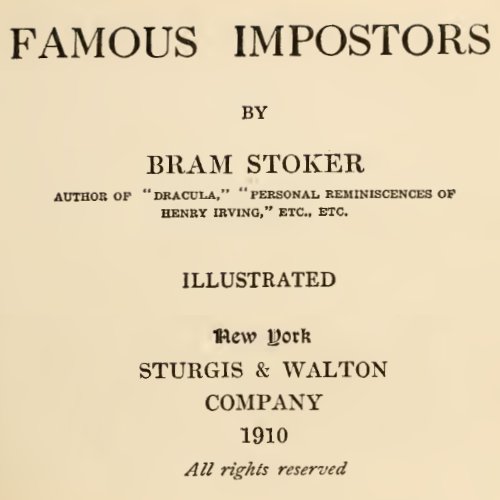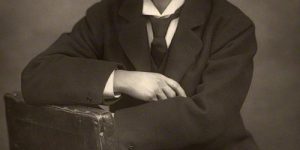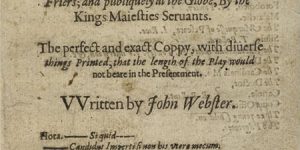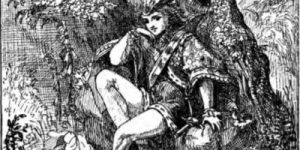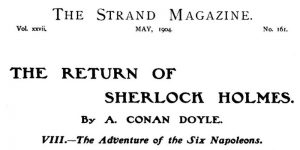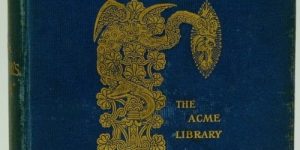The False Dauphins : Famous Impostors by Bram Stoker
Famous Impostors : Pretender The False Dauphins
by
Bram Stoker
The False Dauphins
On 21 January, 1793, Louis XVI of France was beheaded in the Place de la Revolution, formerly Place de Louis Quinze. From the moment his head fell, his only son the Dauphin became by all constitutional usage, his successor, Louis XVII. True the child-king was in the hands of his enemies; but what mattered that to believers in the “Divine Right.” What mattered it either that he was at that moment in the prison of the Temple, where he had languished since August 13, 1792, already consecrated to destruction, in one form or another. He was then under eight years of age, and so an easy victim. His gaoler, one Simon, had already been instructed to bring him up as a “sansculotte.” In the furtherance of this dreadful ordinance he was taught to drink and swear and to take a part in the unrighteous songs and ceremonies of the Reign of Terror. Under such conditions no one can be sorry that death came to his relief. This was in June, 1795—he being then in his eleventh year. In the stress and turmoil of such an overwhelming cataclysm as the Revolution, but little notice was taken of a death which, under other circumstances, would undoubtedly have been of international interest if not of importance. But by this time the death of any one, so long as it was by violence, was too common a matter to cause concern to others. The Terror had practically glutted the lust for blood. Under such conditions but little weight was placed on the accuracy of records; and to this day there survive practical inconveniences and difficulties in daily life from the then disruption of ordered ways. The origin of such frauds or means of fraud as are now before us is in uncertainty. Shakespeare says:
“How oft the sight of means to do ill deeds Makes ill deeds done.”
The true or natural criminal is essentially an opportunist. The intention of crime, even if it be only a desire to follow the line of least resistance, is a permanent factor in such lives, but the direction, the mechanism, and the scope of the crime are largely the result of the possibilities which open and develop themselves from a fore-ordered condition of things.
Here then was the opening which presented itself at the end of the eighteenth century. France was in a state of social chaos. The fountains of the deep were stirred, and no human intelligence could do more than guess at what might result from any individual effort of self-advancement. The public conscience was debauched, and for all practical purposes the end justified the means. It was an age of desperate adventure, of reckless enterprise, of unscrupulous methods. The Royalty of France was overthrown—in abeyance till at least such a time as some Colossus of brains or energy, or good fortune, should set it up again. The hopes of a great nation of return to a settled order of things through constitutional and historical channels were centred in the succession to the Crown. And through the violence of the upheaval any issue was possible. The state of affairs just before the death of Louis XVII gave a chance of success to any desperate fraud. The old King was dead, the new King was a child and in the hands of his bitterest enemies. Even if anyone had cared to vindicate his rights there seemed at present no way of accomplishing this object. To any reckless and unscrupulous adventurer here was an unique chance. Here was a kingship going: a daring hand might grasp the crown which rested in so perilous a manner on the head of a baby. Moreover the events of the last fifteen years of the century had not only begotten daring which depended on promptness, but had taught and fostered desperation. It is a wonder to us who look back on that time through the safety-giving mist of a century, not that there was any attempt to get a crown, if only by theft, but that there were not a hundred attempts made for each one that history has recorded.
As a matter of fact, there were seven attempts made to personate the dead Dauphin, son of Louis XVI, that “son of St. Louis,” who, in obedience to Abbé Edgworth’s direction to “ascend to heaven,” went somewhere where it is difficult—or perhaps inexpedient—to follow him.
The first pretender appears to have been one Jean Marie Hervagault, son of a tailor. His qualification for the pretence appears to have been but a slender one, that of having been born in 1781, only about three years before the Dauphin. This, taken by itself, would seem to be but a poor equipment for such a crime; but in comparison with some of the later claimants it was not without reason of approximate possibility as far as date was concerned. It was not this criminal’s first attempt at imposture, for he had already pretended to be a son of la Vaucelle of Longueville and of the Duc d’Ursef. Having been arrested at Hottot as a vagabond, he was taken to Cherburg, where he was claimed by his father. When claiming to be, like the old man in Mark Twain’s inimitable Huckleberry Finn, “the late Dauphin,” his story was that he had as a child been carried from the prison of the Temple in a basket of linen. In 1799 he was imprisoned at Chalons-sur-Marne for a month. He was, however, so far successful in his imposture as Louis XVII, that after some adventures he actually achieved a good following—chiefly of the landed interest and clerics. He was condemned to two years’ imprisonment at Vitry, and afterwards to a term of twice that duration, during which he died, in 1812.
The second and third aspirants to the honour of the vacant crown were inconspicuous persons possessing neither personal qualification nor apparent claim of any sort except that of a desire for acquisition. One was Persat, an old soldier; the other, Fontolive, a bricklayer. The pretence of either of these men would have been entirely ridiculous but for its entirely tragic consequences. There is short shrift for the unsuccessful impostor of royalty—even in an age of fluctuation between rebellion and anarchy.
The fourth pretender was at least a better workman at crime than his predecessors. This was Mathurin Brunneau—ostensibly a shoemaker but in reality a vagabond peasant from Vezins, in the department of Maine-et-Loire. He was a born criminal as was shown by his early record. When only eleven years of age he claimed to be the son of the lord of the village, Baron de Vezins. He obtained the sympathy of the Countess de Turpin de Crisse, who seemed to have compassion for the boy. Even when the fraud of his parentage was found out she took him back into her household—but amongst the servants. After this his life became one of adventure. When he was fifteen he made a tour through France. In 1803 he was put in the House of Correction at St. Denis. In 1805 he enlisted as a gunner. In 1815 he re-appeared with an American passport bearing the name of Charles de Navarre. His more ambitious attempt at personation in 1817, was not in the long run successful. He claimed his rights, as “Dauphin” Bourbon under Louis XVIII, was arrested at St. Malo, and confined at Bicêtre. He got round him a gang of persons of evil life, as shown by their various records. One was a false priest, another a prisoner for embezzlement, another an ex-bailiff who was also a forger, another a deserter; with the usual criminal concomitant of women, dishonoured clergy and such like. At Rouen he was sentenced to pay a fine of three thousand francs in addition to imprisonment for seven years. He died in prison.
The imposture regarding the Dauphin was like a torch-race—so soon as the lighted torch fell from the hand of one runner it was lifted by him who followed. Brunneau, having disappeared into the prison at Rouen, was succeeded by Henri Herbert who made a dramatic appearance in Austria in 1818. At the Court in Mantone, the scene of his appearance, he gave the name of Louis Charles de Bourbon, Duc de Normandie. His account of himself, given in his book published in 1831, and republished—with enlargements, by Chevalier del Corso in 1850, is without any respect at all for the credulity of his readers.
The story tells how an alleged doctor, one answering to the not common name of Jenais-Ojardias, some time before the death of the Dauphin had had made a toy horse of sufficient size to contain the baby king, the opening to the interior of which was hidden by the saddle-cloth. The wife of the gaoler Simon, helped in the plot, the carrying out of which was attempted early in 1794. Another child about the Dauphin’s size, dying or marked for death by fatal disease, was drugged and hidden in the interior. When the toy horse was placed in the Dauphin’s cell the children were exchanged, the little king having also been drugged for the purpose. It would almost seem that the narrator here either lost his head or was seized with a violent cacoethes scribendi, for he most unnecessarily again lugs in the episode adapted from Trojan history. The worthy doctor of the double name had another horse manufactured, this time of life size. Into the alleged entrails of this animal, which was harnessed with three real horses as one of a team of four, the Dauphin, once more drugged, was concealed. He was borne to refuge in Belgium, where he was placed under the protection of the Prince de Condé. By this protector he was, according to his story, sent to General Kléber who took him to Egypt as his nephew under the name of Monsieur Louis. After the battle of Marengo in 1800, he returned to France, where he confided his secret to Lucien Bonaparte and to Fouché (the Minister of Police), who got him introduced to the Empress Josephine, who recognised him by a scar over his right eye. In 1804 (still according to his story), he embarked for America and got away to the banks of the Amazon, where amid the burning deserts (as he put it) he had adventures capable of consuming lesser romancists with envy. Some of these adventures were amongst a tribe called “the Mamelucks”—which name was at least reminiscent of his alleged Egyptian experiences. From the burning deserts on the banks of the Amazon he found his way to Brazil, where a certain “Don Juan,” late of Portugal and at that time Regent of Brazil, gave him asylum.
Leaving the hospitable home of Don Juan, he returned to Paris in 1815. Here Condé introduced him to the Duchesse d’Angoulême (his sister!) and according to his own naïve statement “the Princess was greatly surprised,” as indeed she might well have been—quite as much as the witch of Endor was by the appearance of Samuel. Having been repulsed by his (alleged) sister, the alleged king made a little excursion, embracing in its erratic course Rhodes, England, Africa, Egypt, Asia Minor, Greece, and Italy. When in Austria he met Silvio Pellico in prison. Having spent some years himself in prison in the same country, he went to Switzerland. Leaving Geneva in 1826, he entered France, under the name of Herbert. He was in Paris the following year under the name of “Colonel Gustave,” and forthwith revived his fraud of being “the late Dauphin.” In 1828, he appealed to the Chamber of Peers. To this appeal he appears to have received no direct reply; but apropos of it, Baron Mounier made a proposition to the Chamber that in future no such application should be received unless properly signed and attested and presented by a member of the Chamber. He gathered round him some dupes who believed in him. To these he told a number of strange lies based on some form of perverted truth, but always taking care that those of whom he spoke were already dead. Amongst them was the wife of Simon, who had died in 1819. Desault, the surgeon, who had medical care of Louis XVII, and who died in 1795, the ex-Empress Josephine, who died in 1814, General Pichegru, who died in 1804, and the Duc de Bourbon (Prince de Condé) who died in 1818. In the course of his citation of the above names, he plays havoc with generally accepted history—Desault according to him did not die naturally but was poisoned. Josephine died simply because she knew the secret of the young King’s escape. Pichegru died from a similar cause and not by suicide. Fualdes was assassinated, but it was because he knew the fatal secret. With regard to one of his dead witnesses whose name was Thomas-Ignace-Martin de Gallardon, there is a rigmarole which would not be accepted in the nursery of an idiot asylum. There is a mixture of Pagan mythology and Christian hagiology which would have been condemned by Ananias himself. In one passage he talks of seeing suddenly before him—he could not tell (naturally enough) whence he came—a sort of angel who had wings, a long coat and a high hat. This supernatural person ordered the narrator to tell the King that he was in danger, and the only way to avoid it was to have a good police and to keep the Sabbath. Having given his message the visitant rose in the air and disappeared. Later on the suggested angel told him to communicate with the Duc Decazes. The Duke naturally, and wisely enough, handed the credulous peasant over to the care of a doctor. Martin himself died, presumably by assassination, in 1834.
The Revolution of 1830 awoke the pretensions of Herbert, who now appeared as the Baron de Richmont, and wrote to the Duchesse d’Angoulême, his (supposed) sister, putting on her the blame of all his troubles. But the consequences of this effort were disastrous to him. He was arrested in August, 1833. After hearing many witnesses the Court condemned him to imprisonment for twelve years. He was arraigned under the name of “Ethelbert Louis-Hector-Alfred,” calling himself the “Baron de Richmont.” He escaped from Clairvaux, whither he had been transferred from Saint-Pélagie, in 1835. In 1843 and 1846 he published his memoirs—enlarged but omitting some of his earlier assertions, which had been disproved. He returned to France after the amnesty of 1840. In 1848 he appealed—unheeded—to the National Assembly. He died in 1855 at Gleyze.
The sixth “Late Dauphin” was a Polish Jew called Naundorf—an impudent impostor not even seeming suitably prepared by time for the part which he had thus voluntarily undertaken, having been born in 1775, and thus having been as old at the birth of the Dauphin as the latter was when he died. This individual had appeared in Berlin in 1810, and was married in Spandau eight years later. He had been punished for incendiarism in 1824, and later got three years’ imprisonment at Brandenburg for coining. He may be considered as a fairly good all-round—if unsuccessful—criminal. In England he was imprisoned for debt. He died in Delft in 1845.
The last attempt at impersonating Louis XVII, the seventh, afforded what might in theatrical parlance be called the “comic relief” of the whole series, both as regards means and results. This time the claimant to the Kingship of France was none other than a half-bred Iroquois, one called Eleazar, who appeared to be the ninth son of Thomas Williams, otherwise Thorakwaneken, and an Indian woman, Mary Ann Konwatewentala. This lady, who spoke only Iroquois, said at the opportune time she was not the mother of Lazar (Iroquois for Eleazar). She made her mark as she could not write. Eleazar had been almost an idiot till the age of thirteen; but, being struck on the head by a stone, recovered his memory and intelligence. He said he remembered sitting on the knees of a beautiful lady who wore a rich dress with a train. He also remembered seeing in his childhood a terrible person; shewn the picture of Simon he recognised him with terror. He learned English but imperfectly, became a Protestant and a missionary and married. His profile was something like that of the typical Bourbon. In 1841, the Prince de Joinville, seeing him on his travels in the United States, told him (according to Eleazar’s account) that he was the son of a king, and got him to sign and seal a parchment, already prepared, the same being a solemn abdication of the Crown of France in favour of Louis Philippe, made by Charles Louis, son of Louis XVI, also styled Louis XVII King of France and Navarre. The seal used was the seal of France, the one used by the old Monarchy. The “poor Indian with untutored mind” made with charming diffidence the saving clause regarding the seal,—”if I am not mistaken.” Of course there was in the abdication a clause regarding the payment of a sum of money “which would enable me to live in great luxury in this country or in France as I might choose.” The Reverend Eleazar, despite his natural disadvantages and difficulties, was more fortunate than his fellow claimants inasmuch as the time of his imposture was more propitious. Louis Philippe, who was always anxious to lessen the danger to his tottering throne, made a settlement on him from his Civil List, and the “subsequent proceedings interested him no more.”
Altogether the Louis XVII impostures extended over a period of some sixty years, beginning with Hervagault’s pretence soon after the death of the Dauphin, and closing at Gleyze with the death of Henri Herbert, the alleged Baron de Richmont who appeared as the alleged Duc de Normandie.
Famous Impostors
Chapter I. Pretenders
A. Perkin Warbeck
B. The Hidden King
C. Stephan Mali
D. The False Dauphins
E. Princess Olive
Chapter II. Practitioners of Magic
A. Paracelsus
B. Cagliostro
C. Mesmer
Chapter III.
The Wandering Jew
Chapter IV.
John Law
Chapter V. Witchcraft and Clairvoyance
A. Witches
B. Doctor Dee
C. La Voisin
D. Sir Edward Kelley
E. Mother Damnable
F. Matthew Hopkins
Chapter VI.
Arthur Orton (Tichborne claimant)
Chapter VII. Women as Men
A. The Motive for Disguise
B. Hannah Snell
C. La Maupin
D. Mary East
Chapter VIII. Hoaxes, etc.
A. Two London Hoaxes
B. The Cat Hoax
C. The Military Review
D. The Toll-Gate
E. The Marriage Hoax
F. Buried Treasure
G. Dean Swift’s Hoax
H. Hoaxed Burglars
I. Bogus Sausages
J. The Moon Hoax
Chapter IX.
Chevalier d’Eon
Chapter X.
The Bisley Boy

